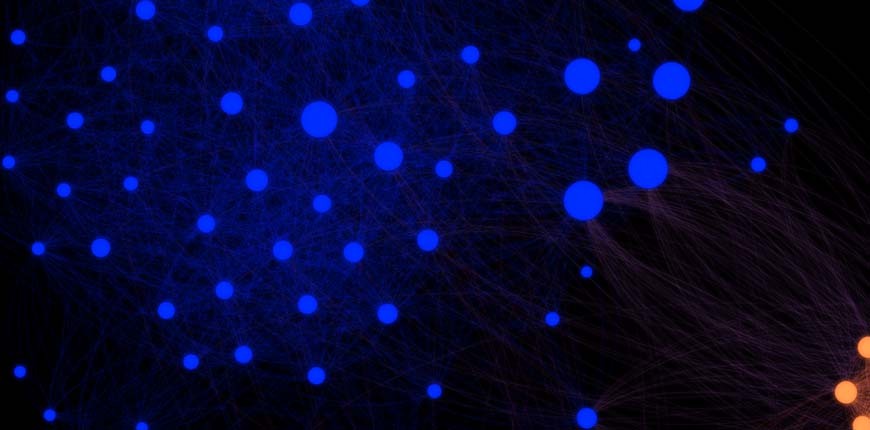Who is a key player in the parliament and who is, on the contrary, a “makeweight”? Which legislators do cooperate and which refuse to “communicate”? The analysts of KohoVolit.eu attempt to answer these questions using network analysis, a unique method combining the art of statistics and visualization.
The right to propose bills is entitled to individual MPs or groups of MPs in many parliaments. Network analysis helps to reveal, which groups of proposers are created and what influences their composition. As the designation suggests, network analysis is a statistical method, which examines networks, thus mutual connections (or so-called “edges”) among various entities (or so-called “knots”).
The knots can represent groups of people (e.g. parliamentary clubs), individuals (e.g. legislators), inanimate objects (e.g. bills) or even abstract entities such as words or ideas. The edges usually represent some kind of a unilateral or bilateral interaction, connection, cooperation, proximity or membership.
Let’s demonstrate the power of network analysis on the example of bill proposers in the Chamber of Deputies of the Czech Parliament in the functional term of 2010-2013. Each knot of this network represents one deputy and each edge represents the bills that were submitted by two deputies collectively (either as a pair or together with other deputies). The more frequently two deputies proposed bills collectively, the more noticeable is the edge, which connects them.
Analysis created in Gephi programme. Force Atlas is the cluster algorithm used. Author: Kamil Gregor, KohoVolit.eu.
It is obvious that deputies form three manifestly separated clusters, which corresponds with the division of the chamber to parliamentary clubs. The red cluster at the bottom includes deputies of the communist KSČM, the orange cluster on the bottom left represents deputies of the social democratic ČSSD and in the large blue cluster, we can see the deputies of the governmental coalition of liberal-conservative parties ODS and TOP 09 and the populist party VV.
Particular governmental parties are distinguishable in the blue cluster if we remove the descriptions of surnames and parliamentary clubs of deputies from the picture.
Analysis created in Gephi programme. Force Atlas is the cluster algorithm used. Author: Kamil Gregor, KohoVolit.eu.
The cluster of deputies from ODS party is visible in the upper left part of the blue cloud, the cluster of TOP 09 deputies in the lower right part of the cloud and the cluster of VV deputies can be seen in the lower left part of the cloud. Deputies representing the VV party have strong connections with other governmental deputies (blue) but also with opposition deputies from the ČSSD party, since VV left the government during the functional term and joined the opposition. So basically, in the beginning they proposed bills together with their governmental colleagues and later with the opposition deputies.
Deputies cluster mainly with their colleagues from the same party because they frequently propose bills collectively. It is worth noticing that the cluster of social-democrats (orange) is more packed than the cluster of governmental deputies (blue). That is due to the fact, that when ČSSD proposed a bill, almost all members of its parliamentary club signed it in most cases. Their mutual connection is therefore much stronger and the network analysis pushes them together.
The cluster of deputies of governmental parties (blue) is much looser, as the governmental deputies in fact do not have to propose bills. It is done through the government, which is the most frequent proposer. In this functional term, it has submitted even 341 out of 614 bills. Thus, if governmental deputies propose a bill, they do so in much smaller groups. Their mutual connection is therefore overall weaker, which is reflected in the network analysis as a loose cluster.
The size of knots corresponds with the quantity called the centrality rate. It captures not only the frequency of bill proposing by a deputy, but also how frequently it is done with other deputies. The network analysis pushes the knots with the high centrality rate to the middle of the network. These deputies, such as Petr Gazdík, Stanislav Polčák (both from TOP 09), Jeroným Tejc, Jan Babor (both from ČSSD) or Pavel Kováčik, Vladimír Koníček, Kateřina Konečná (all from KSČM), are predominantly the presidents of parliamentary clubs.
The signature of these deputies means, that the entire parliamentary club supports the particular bill, so that is why they have a lot of connections with other deputies. Also, exactly these deputies sign uncontroversial bills, which is why they often have the strongest connections with deputies from different parliamentary clubs, too.
Around the perimeter of the network, we can find such governmental deputies (blue), which are almost not connected with their colleagues, at all. This includes for example Pavel Drobil, Petr Nečas (both from ODS), Jiří Besser, Karel Schwarzenberg (both from TOP 09). These are members of the government, which were deputies at the same time. They rarely propose bills since they are responsible for those submitted by the government.
Near the centre, there are two interesting deputies: Jan Farský from TOP 09 is located outside the blue cluster of the governmental coalition, almost in the middle among the three major clusters. That is due to the fact that he was a proposer of several bills, that had broad support, which is why he has strong connections with deputies from all the parliamentary clubs. At first glance, Ivana Levá from KSČM is interesting too, for proposing quite a high number of bills with deputies from other clubs, ČSSD in particular.
Finally, it is important to mention that the network does not have to create only a static image, but we can also put it into motion.
 Visualization created using javascript library d3.js. Author: Michal Škop, KohoVolit.eu.
Visualization created using javascript library d3.js. Author: Michal Škop, KohoVolit.eu.



